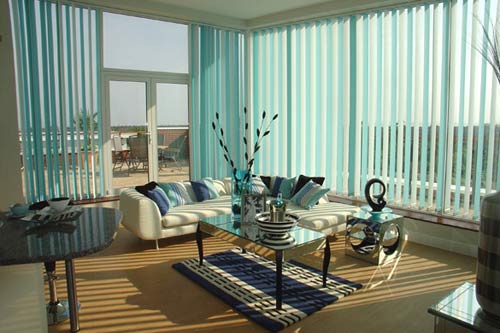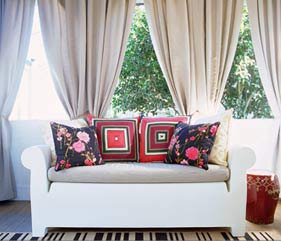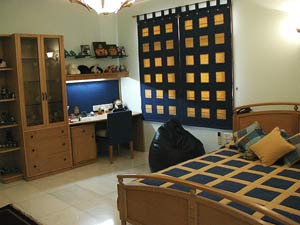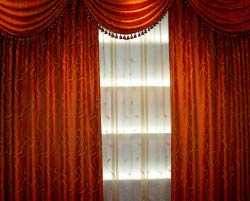Soft furnishings - make the right choice
By Aruna Rathod | 20 Feb 2009
Furnishing a room is one of the most challenging tasks as it can make or break the look of a room. The look of a room is enhanced with the right choice of Soft furnishing which includes the curtains, upholstery, lamp shades, cushions and, floor coverings etc like rugs, throws.
Gulshan Kwatra and her daughter Nandita run Patchcraft, a furnishings consultancyoutlet. With more than 25 years of designing hotel rooms and premium homes to their credit, the duo has an eye for picking up the finest fabrics and transforming interiors by combining colours, textures and patterns.
The artists of embellishments give us easy tips on how to go about designing your home.

Which fabric to use where
In a room the main areas that use soft furnishing are sofas, curtains, cushions and rugs. The most important points to be considered while choosing a fabric for soft furnishings is the appearance, maintenance, the economically viability of the fabric which means the fabric should be washable at home, yet lasts and lasts. Home decor fabrics in the market include fine silks, linens, cottons, polyesters and imported fabrics. While choosing the most important factor is to be pragmatic.
Sofas When selecting fabric for the sofas and chairs, the best choice is thick fabrics. Durability is the key factor. Silk is usually not advised for upholstery, as the fine natural fibres will tear when even with a little pressure or rough usageis applied. Avoid using jute as the fibres tend to come outfray and it is too rough on the skin. Not advisable for large surfaces.
When selecting fabric for the sofas and chairs, the best choice is thick fabrics. Durability is the key factor. Silk is usually not advised for upholstery, as the fine natural fibres will tear when even with a little pressure or rough usageis applied. Avoid using jute as the fibres tend to come outfray and it is too rough on the skin. Not advisable for large surfaces.
Bigger pieces of furniture like sofas, loungers should be upholstered in poly-silks or poly-cottons as these are easy to maintain. Depending on which room you are furnishing, look for strong tight weaves like jacquard, linen, heavy weight tussars and silks (100 gms and above). For rooms that are frequently used, like living rooms and bedrooms, it is ideal to use poly-mixes or synthetic fabrics as these are easiery to maintain and can be home-washedeasily washable at home. To add an elegant look to the space, you can use silk fabrics for cushions as accent pieces.
Care for your sofa
Scotch Guard, a chemical composition that’s sprayed on the fabric and forms a thin protective layer, increases the life span of fabrics as it doesn't let the fabric absorb any liquids. as it forms a barrier. Some Note: Scotch Guard is done by the upholstery stores offer to dab a coat of Scotch Guard as part of their service. themselves.
If you have pets and small children at home, use loose covers on sofas as these can be removed regularly to wash.
Vaccuum clean your sofas at regular intervals.
To clean velvet fabric, use a soft brush.
Curtains  For curtains it is ideal to use poly-silks and poly-satins as they lend a rich look.
For curtains it is ideal to use poly-silks and poly-satins as they lend a rich look.
When choosing a fabrics for curtains, check for the weight and drape. Do not use a stiff, heavy fabric if you want pleated curtains, as it will not form those gorgeous gathers. nicely.
Linings - Iif you are using an uncoated fabric, lining is essential s are an essential part of the making as it helps in many ways. It of your drapes, as they provide protection for strengthens the your drapery of the fabric. It , blocks out more light and helps your drapes to act as insulation. A good quality lining can also help to extend the life of your drapes.
Always consider the amount of sunlight that comes into the room. position of the sun. South facing rooms get the sun all day and some fabrics will fade over time if exposed to strong sunlight. It is best to steer clear of using silk fabrics in very sunny rooms. North facing rooms are generally dark and can feel cold as they get little sun. In this case, a brighter colour scheme may be the answer.
It is important to take into account not only the function and style of the room but also the size of the window.
Types of fabrics - curtains Poly-cotton blends, - made by blending when natural fibres such as cotton are woven with man-made material such as polyester. This can help to make the resulting fabric more durable, more resistant to creasing and less likely to lose its colour.
Poly-cotton blends, - made by blending when natural fibres such as cotton are woven with man-made material such as polyester. This can help to make the resulting fabric more durable, more resistant to creasing and less likely to lose its colour.
Sheers - are usually filmy, translucent fabrics, often with a soft sheen. If used alone as a window treatment, sheers are usually a decorative option, as they do not ensure privacy when a room is lit from the inside. They should be in 100 percent polyester.
Voiles - light, semitransparent fabrics. Usually a plain-weave, sheer fabric of cotton, rayon, silk, or wool, voiles are also used for decorative purposes and teamed with drapes to provide privacy and light control if required. Voile is a limp fabric no body but gives a soft dreamy look. Mild starching should be done to give body to the fabric.
Organic fibres - banana fibre - expensive but goes limp. It also has a tendency to attracts fungus through moisture.
Linen is delicate and should be handled with care.






























